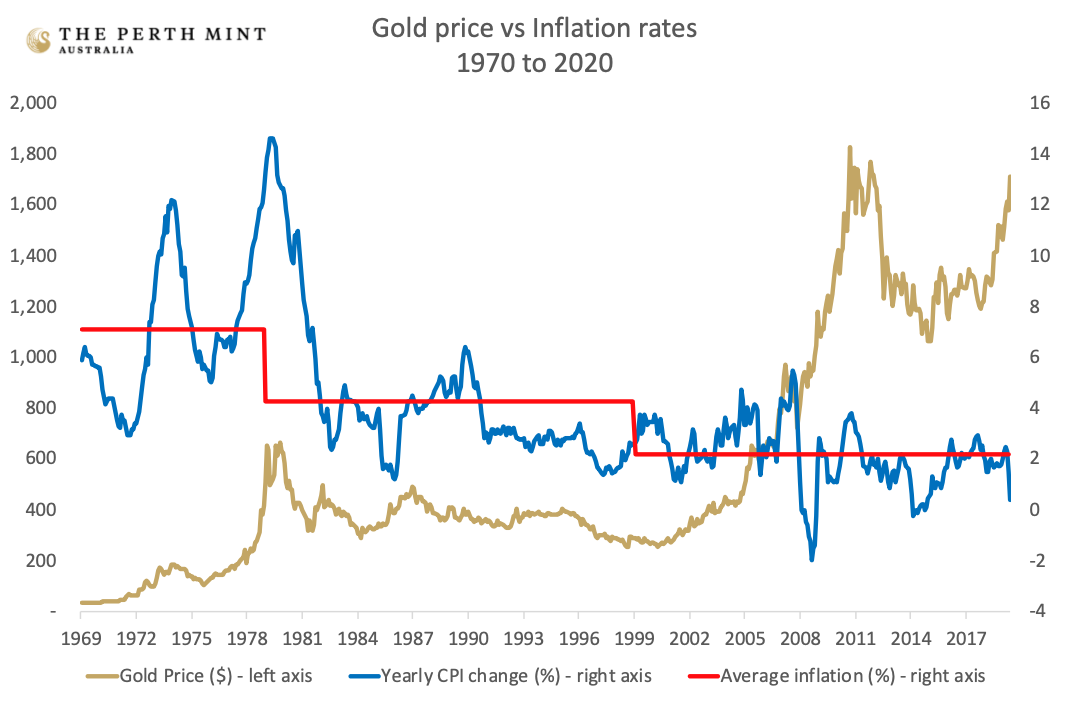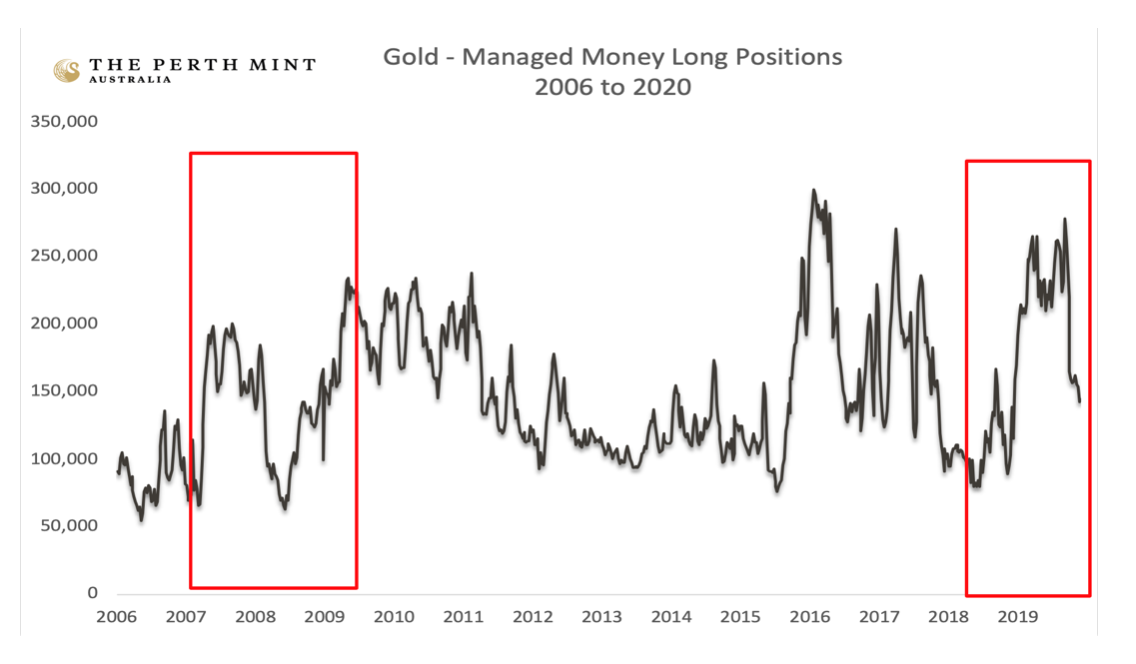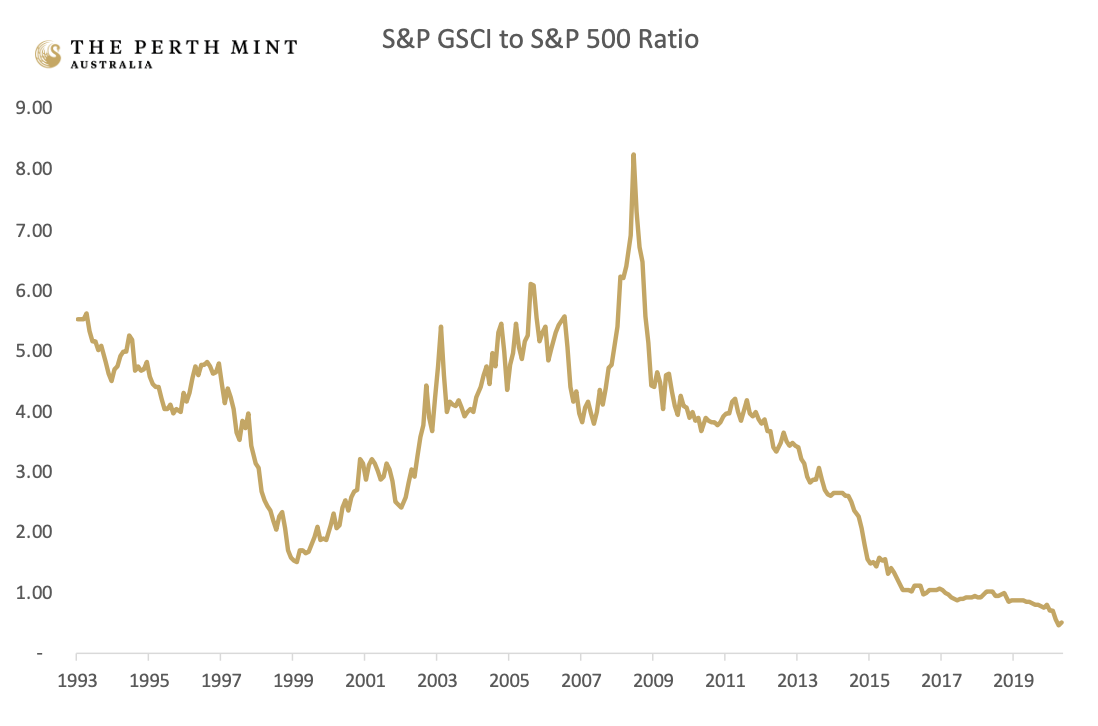Gold: The GFC vs COVID-19 and the inflation myth
Gold prices have continued their bull market run in Q2 2020, with the yellow metal trading above USD 1,700 per troy ounce. This reflects a sustained upward trajectory that began in earnest during the final quarter of 2018, with the price increasing in US dollar terms by more than 40% over this time period.
This year the spread of COVID-19 and the economic fallout from steps taken to contain it have been major drivers of gold’s upward move as risk-conscious investors take steps to diversify their portfolios.
A range of high-profile investors are also adding their voices to the call to include gold in a diversified portfolio.
In a May 17th 2020 article titled Hedge fund luminaries are lining up to behind gold again , Bloomberg noted that investors like Paul Singer, David Einhorn and Crispin Odey have recently sent out letters to investors that are decidedly bullish on gold, whilst asset managers like Blackrock are also reported to have a positive view on the metal.
Odey wrote, “Gold is the only escape from global monetising”.
Singer stated that gold could go to “multiples of its current price” and “is one of the most undervalued investable assets existing today”.
The Bloomberg article then goes on to question the legitimacy of the bullish outlook for gold. It does this by implying that the case for gold in 2020 (low rates, higher fiscal deficits and central bank debt monetisation, all of which create fears of higher inflation) is essentially a re-run of the thesis that first surfaced during the Global Financial Crisis (GFC).
The article states: “It’s a familiar investment thesis in the gold market, and the last time it was tried, in 2008, it fell flat. The most prominent gold champion back then, John Paulson, predicted ‘massive inflation’ which ‘never materialised’”.
In this Livewire update we examine four similarities and seven key differences between the COVID-19 and GFC era as they relate to the outlook for gold. The article will look at investor flows into the precious metal, as well as the macroeconomic, market and monetary forces at play during both crises.
But first, we want to address the suggestion that low inflation is bad for gold or indeed invalidates the case for investing in gold bullion.
The inflation myth
I have been a gold bull since the early 2000s, investing in the metal throughout the majority of the more than 20 years I have worked in financial markets. During this time period, I have repeatedly heard the assertion that gold only performs well during periods of high inflation.
This belief is likely tied to the performance of gold in the 1970s, when stagflation took hold in the United States and other parts of the developed world. Gold was the standout performer during this decade.
This is seen in the chart below, which plots the price of gold (gold line) from 1970 to the end of April 2020, as well as year on year changes in inflation rates (blue line). The chart also shows the average inflation rate (red line) across the three major gold cycles we’ve seen in the last 50 years including:
- The gold bull cycle of the 1970s (annual average inflation rate 7.09%)
- The gold bear cycle of the 1980s and 1990s (annual average inflation rate 4.28%)
- The gold bull cycle from 2000 to 2020 (annual average inflation rate 2.16%)

Source: The Perth Mint, Reuters, St Louis Federal Reserve
As you can see, despite some of the lowest average inflation rates on record during the first two decades of the new millennium, the gold price has soared. If gold relied on high rates of inflation to perform well, then the price should have fallen for much of the last 20 years.
Instead it has gone up by almost 500%, with the yellow metal outperforming most mainstream asset classes over this period. This tells us conclusively that the idea that gold only does well during periods of high inflation is a myth.
Note, this is not to say that inflation isn’t a relevant factor for gold, or that higher inflation wouldn’t support higher gold demand. We are just highlighting the fact that market history over the past 20 years proves that gold is not just an inflation hedge.
Rather physical gold has zero credit risk, is highly Iiquid, has generated strong long-term returns and has proved to be an effective hedge against a range of unpleasant economic outcomes, of which high inflation is just one.
The outlook for gold
Key similarities between the GFC and COVID-19
1. Price movements
The most obvious similarity is the performance trajectory. Gold prices were strong leading into the GFC, suffered a correction as a liquidity crunch saw investors desperate to raise cash, and then rebounded strongly.
This time around we’ve seen a similar dynamic at play, with gold performing very well in the lead in to the COVID-19 crisis. The gold price then suffered a pullback of more than 10% in March 2020, but has has since recovered those losses in full.
2. Physical and ETF demand
Another similarity is the strong demand being seen for the precious metal. The Perth Mint has seen this firsthand, with General Manager Minted Products, Neil Vance recently commenting that “we have seen sales in the last two months that we haven’t seen since the Global Financial Crisis in 2008 and 2009.”
Another example of the strong demand for gold is seen in the table below, which highlights the five calendar quarters that saw the largest inflows into gold exchange traded funds (ETFs) globally.

Source: The Perth Mint, World Gold Council
As you can see, the largest ever inflows into gold ETFs in any given calendar quarter was recorded in Q1 2009, right at the zenith of the GFC induced equity market correction, and in the immediate aftermath of the launch of the Federal Reserve’s (The Fed) original quantitative easing (QE) package.
Third place on the table is taken up by Q1 2020, whilst fifth spot belongs to the June quarter this year, even though we are only half way through it at the time of writing, with the +275 tonnes of inflows covering the time period from 31 March to 15 May 2020.
3. Futures market positioning
Managed money activity in the futures market has also shown similar trends in both crises.
Between August 2007 and late February 2008 (which was the month Northern Rock was nationalised, and one month prior to JP Morgan buying Bear Sterns), managed money long positions rose from around 65,000 contracts to more than 200,000 contracts.
They then proceeded to drop all the way back to just below 63,000 contracts by late November 2008, which was barely two months after Lehman Bros had filed for Chapter 11 and precisely the same time The Fed announced their QE1 package.
Over the 12 months that followed the announcement of QE1, managed money long positions rose again to more than 225,000 contracts as speculators helped push the gold price up by more than 45% in that one-year period.
This time around managed money long positions rose strongly prior to the global economic shutdown that COVID-19 caused, rising from just 80,000 contracts in November 2018 to almost 280,000 contracts by late February 2020. Over the last three months they have again been pared back, dropping to just over 140,000 by 12 May 2020.
This activity in the futures market is seen in the line chart below, which plots positioning on a weekly basis all the way back to June 2006. The areas inside the red boxes reflect the periods we’ve mentioned above.

Source: The Perth Mint, CFTC, Ycharts.com
If history repeats, then hedge funds and the like have a lot of room to add to their long gold positions from here, which would likely have bullish implications for prices.
4. Equity valuations
Equity valuations are also an important factor when assessing the outlook or gold in the COVID-19 era relative to the GFC. Using Shiller CAPE we can see that equities peaked at a price earnings multiple of around 30 in 2007.
Today, despite the sharp sell-off seen during Q1 2020, the latest estimates suggest multiples are still sitting around 30. This is more or less exactly the same valuation point seen before the more than 50% decline in equities during the GFC.
History demonstrated that investors who hedged against the risk of a sharply falling equity market during the GFC strongly outperformed those who didn’t. There are no guarantees as to what the future holds, but there seems little reason to think those hedges are not needed in today’s COVID-19 environment.
Key differences between the GFC and COVID-19
1. Health crisis complicates path forward
Moving on to the differences between the two crises, and the most obvious one is the nature of threat itself. The GFC was a result of capital misallocation, over indebtedness amongst financially stretched households and excessive leverage in the financial system itself.
Challenging though it was, there was no public health threat complicating the policy response, nor the path out of the crisis. This time around it is a, as yet unresolved, public health threat that has forced a policy response which has led to the economic fallout.
The path forward is more uncertain. After all, we can’t simply legislate or print a vaccine into existence.
2. Debt levels
Another major difference today in comparison to the challenge faced during the GFC are total debt levels, especially levels of government debt. According to an April 2020 update from the Institute of International Finance (IIF), global debt levels have now topped USD 255 trillion and are sitting at more than 322% of GDP.
That is some 40% higher than when the GFC hit, with the business and finance outlook for 2019 from the Organisation for Economic Co-operation and Development (OECD), highlighting that “the post crisis strategy pursued by many governments to increase fiscal deficits to boost stimulus contributed to a rise of global sovereign debt from 62% of GDP in 2008 to a peak of 83% in 2017”.
There is no doubt that public balance sheets are in an overextended starting position today relative to that of a decade ago.
3. Yields are much lower
Yields are also much lower now relative to the GFC.
Across 2007 and 2008, US 10-year treasury yields averaged 4.10%. On 15 May 2020 the US 10-year yield was sitting at just 0.64%, a decline of almost 85%.
This is important for two reasons.
The first is that governments (and indeed all debtors) have already benefitted from an 85% decline in yields over the last decade, in terms of lower servicing costs on the money they borrow.
This tailwind is unlikely to be repeated, unless long-term bond yields fall into deeply negative territory, a scenario that would create its own set of problems should it come to pass.
The second reason it’s important is that from an investment perspective, the risk-free return one could earn in treasury bonds during the GFC has turned into return-free risk today, not just in America but around the world.
You will get your money back, but even if today’s historically low inflation rates hold for another decade, it will not have maintained its purchasing power.
The return-free risk also applies at the shorter end of the market too, with cash rates again up against, and indeed in some cases already below, the zero-lower bound.
This is a problem that is particularly acute for Australian retirees with money in term deposits. It’s worth remembering that even during the worst of the GFC, the cash rate in Australia never dropped below 3%.
Today the cash rate is just 0.25%, with implied yields suggesting there will be more easing to come, whilst in the US, markets are now pricing in the arrival of negative interest rates by early 2021.
At a portfolio level, the negative real yields on cash and vast swathes of the sovereign debt market- combined with richly priced equity markets, means prospective returns for diversified investors are far lower today than they’ve been in the past.
Indeed, according to the 2020 Global Investment Yearbook, investors with a 60/40 allocation to stocks and bonds can expect real returns of just 2% going forward.
With this backdrop, combined with the fact that the opportunity cost of investing in gold is significantly lower in 2020 relative to the GFC environment suggests gold should be well supported for some time to come.
4. Monetary and fiscal policy more expansive
The fiscal response to COVID-19 is also dwarfing what was deployed during the GFC. According to the statistics in this article, the fiscal deficit of all the nations highlighted (when weighted by each nation’s 2009 output) was 4.34% of GDP. The same measurement gives us a projected fiscal deficit of 7.34% of GDP in response to COVID-19.
The attitude to unconventional monetary policy is also completely different today. When the GFC hit, QE and zero interest rate policy (ZIRP) were treated as emergency monetary stimulus, to be used with extreme caution and removed as quickly as possible. Today, QE and ZIRP are implicitly seen as standard elements of the monetary policy response kit.
It’s worth remembering that QE1, announced in late November 2008, and QE2, announced in November 2010 involved just USD $600 billion each, whilst QE3 was just USD 40 billion per month. These numbers seem positively quaint today.
Indeed, in the aftermath of the GFC, it took almost seven years for The Fed balance sheet to grow by USD 3.5 trillion to a pre COVID-19 high of USD 4.52 trillion. This time around the Federal Reserve has added over USD 3 trillion to their balance sheet in just over three months.
And unlike the original forays into the world of QE, there is neither an upper limit on the amount of money to be printed, nor a forecast expiry date for these programs this time around.
Meanwhile, academics, economists and the like have stopped asking how we get the economy into a state where it no longer requires this monetary stimulus to function.
Instead, attention has turned to what other monetary experiments we can try, whether that be an adoption of deeply negative interest rates as per this article from Ken Rogoff, or other initiatives including some of the more radical elements of modern monetary theory.
The monetary hawks are extinct, and whilst looser monetary policy will support markets and the economy (likely the former more than the latter) it is not without consequences. Looking forward, questions will remain about the ability of fiat currency to maintain purchasing power, whether it be measured against consumer or financial asset prices.
5. Supply chain issues and trade uncertainty
In the years ahead, trade tensions and supply chain issues companies may encounter in a potentially fragile geopolitical environment are another important distinction between the COVID-19 crisis and the GFC.
In time, this will flow through to either lower company profits, higher inflation, or a combination of the two. These trends can be expected to support gold demand going forward.
6. Commodity prices are much cheaper
Leading into the GFC, commodity prices were high, having outperformed stock prices for most of the early 2000s. Now the situation couldn’t be more different.
Even before COVID-19 hit, commodity prices were at the lower end of their historical range, having fallen by approximately 75% from their all-time highs seen a decade earlier.
On a relative basis commodity prices have never been cheaper, with the S&P Goldman Sachs Commodity Index to S&P 500 ratio comfortably below 1 today. The chart below shows this ratio was more than 8 when the GFC hit.

Source: The Perth Mint, Reuters, au.investing.com
Any investor who remotely believes in mean reversion will look at a chart like this and be encouraged by the potential for commodity prices to outperform in the decade ahead.
7. Social impacts
Finally, there are the social elements to consider.
Most investors are at least somewhat concerned at what the ‘post’ GFC world looks like, given it is characterised by ever widening wealth inequality and political fragmentation. COVID-19 has shone an even harsher light on the gap between the haves and the have-nots, with the unease feeding higher gold demand.
Summary
Reviewing the set up for gold in the COVID-19 era and how it compares to the experience of the GFC, we can see that there are broad similarities in the performance trajectory of gold through both crises and the market response in terms of demand for the yellow metal.
The differences in the macroeconomic, market and monetary sphere though are not to be ignored. The nature of the threat is more complicated this time around, whilst the geopolitical set up is more fragile, debt levels are higher, interest rates are lower, and equity multiples remain at levels seen prior to the GFC crash.
The end result of this is that the path toward economic recovery and the outlook for diversified investors is significantly more challenging today than it was just over a decade ago.
These factors, combined with the even more aggressive fiscal and monetary policy in place today are all supportive for gold, with demand likely to be more sustained this time around.
Get investment ideas from industry insiders
Liked this wire? Hit the follow button below to get notified every time I post a wire. Not a Livewire Member? Sign up for free today to get inside access to investment ideas and strategies from Australia’s leading investors.
Disclaimer:
Past performance does not guarantee future results.
The information in this article and the links provided are for general information only and should not be taken as constituting professional advice from The Perth Mint. The Perth Mint is not a financial adviser. You should consider seeking independent financial advice to check how the information in this article relates to your unique circumstances. All data, including prices, quotes, valuations and statistics included have been obtained from sources The Perth Mint deems to be reliable, but we do not guarantee their accuracy or completeness. The Perth Mint is not liable for any loss caused, whether due to negligence or otherwise, arising from the use of, or reliance on, the information provided directly or indirectly, by use of this article.
4 topics
1 stock mentioned
.jpg)
.jpg)